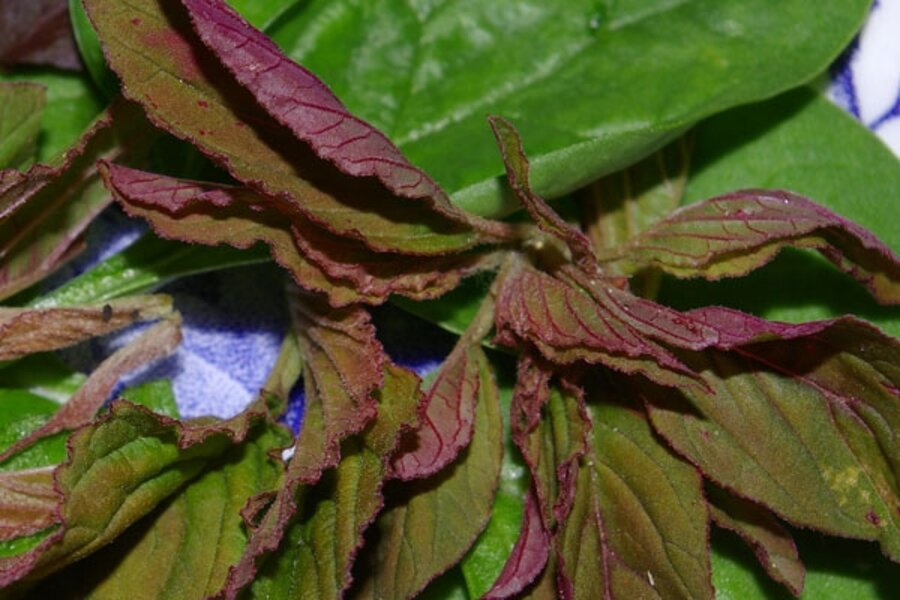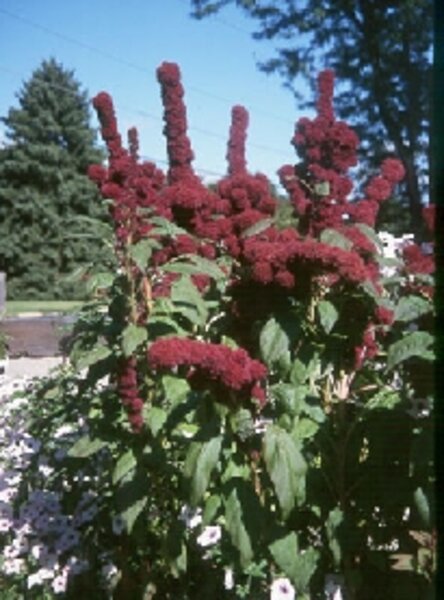Elephants in the garden
Loading...
Burgundy elephants cast shadows on ripening Big Zac tomatoes and another one is crowding the blueberries, as my garden plods towards autumn. Despite a barking dog and fencing to keep out local critters like wild turkeys, bunnies, coons and fox, the elephants remain.
No, I’m not talking about the gigantic equivalent of plastic pink flamingos. These elephants are alive and growing. They’re Elephant Head amaranth (Amarantus gangeticus).
For the past 25 years, I’ve planted the heirloom that German immigrants brought to this country in the 1800s. First, it was because of the flower’s striking beauty. Then I discovered that the plant’s leaves and seeds were edible.
The word amaranth means “everlasting” in Greek, and its tiny seeds have survived for eons, feeding ancient civilizations in South America and Mexico. Today, amaranth flour is popular as a gluten-free, nutritious substitute for wheat flour.
Elephant Head amaranth isn’t a true grain, but a relative of lamb’s quarter and the garden flower cockscomb. Each plant produces 40,000 to 60,000 tiny seeds (see Photo 2 above) that are ground into flour. I use my electric coffee mill and grind enough to use fresh.
New growth tips of plants are tasty, too, for salads or lightly steamed. The greens taste like spinach and are also packed with nutrients.
Plants are easy to grow from seed. Just scratch them into the ground and keep moist until the seeds sprout. Most years, I don’t have to sow, as flowers from the previous year drop plenty of seeds. In fact, the resulting tiny red seedlings, which make Elephant Head easily recognizable, are almost like weeds. They pop up everywhere.
I’ve grown these plants in numerous climates from USDA Zone 9B along the Gulf of Mexico to Zone 4A in frigid Wisconsin. Elephant Head isn’t fussy about soil, moisture, or availability of nutrients. It just grows!
Flowers are so spectacular that I’ve had people steal them out of flower beds in my front yard. (See photo above right.) They keep their color and form well into winter, even in cold climates like mine. I leave the entire plant including the dried flower in the garden for winter interest.
The fresh flowers are as dramatic. Cut a half dozen heads, strip the leaves from stalks and arrange in a tall, heavy vase to use as an everlasting centerpiece. Don’t put water in the vase, let the flowers dry. They retain their vivid color and size for over a year. Keep the flowers out of direct sunlight to prevent colors from fading.
To harvest seeds, wait until flowers are full and mature, usually by mid-September. Shake a flower to see if seeds fall into your hand. Cut heads, lay them on a large screen or sheet of canvas, and let them dry. Then winnow off the chaff to produce clean seed.
I do it an easier way. I cut the heads, bind stalks together, and stick the bunch into a brown paper grocery bag upside down. Bags are hung from hooks on my screen porch.
About two weeks later, all the seeds will be in the bag bottom.
Store seeds in a sealed container in the refrigerator to protect their fatty acids, which contain most of the nutrients. Use seeds within six months. They can be frozen, as can amaranth flour, for up to a year. I use the flour to make low-carbohydrate yeast breads and rolls -- you do have to add a bit of wheat gluten to get the bread to rise.
Ground amaranth seed, mixed with milk and honey, is a popular Mexican hot drink, atole. Cinnamon and chocolate are added to some versions of it.
If it’s edible and unusual, Doreen Howard figures out a way to grow it in her USDA Zone 4b garden. She’ll try anything once, even smelly Durian. A former garden editor at Woman’s Day, she writes regularly for The American Gardener and The Old Farmer’s Almanac’s Garden Guide.
Editor's note: Look for more blog posts by The Edible Explorer, Doreen Howard, at our blog archive. For more Monitor gardening, see our main gardening page and our RSS feed.
You may also want to visit Gardening With the Monitor on Flickr. Take part in the discussions and get answers to your gardening questions. If you join the group (it’s free), you can upload your garden photos and enter our next contest. We'll be looking for photographs of fruits. So find your best shots of summer's blueberries, peaches, plums, etc., and get out your camera to take some stunning shots of early fall apples. Post them before Sept. 30, 2009, and you could be the next winner.






